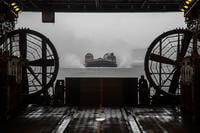Ask Washington’s defense cognoscenti to name the most influential think tank in town and I wager most would say the Center for New American Security (CNAS). While that may be true in terms of shaping the counterinsurgency strategy being applied in the current wars, when it comes to leaving a lasting mark on the future size and shape of the military, Defense Secretary Robert Gates made clear in his speech yesterday at the Navy League’s annual conference that the Center for Strategic and Budgetary Assessments (CSBA) is the real brain trust.
At his first appearance before the Navy fraternity, Gates delivered what will be remembered as the beginning of the most radical transformation of the Navy since the fleet peaked at 592 ships in 1989 and then promptly shrunk. Actually, what’s coming is likely to be even more “radical” as the post-Cold War demobilization hit the fleet with proportional cuts across all platforms. Gates wants to change the fleet’s very makeup. And he cribbed heavily from CSBA in his speech outlining the plan.
Gates began by reminding his audience of the size and striking power of the current battle fleet. “It is important to remember that, as much as the U.S. battle fleet has shrunk since the end of the Cold War, the rest of the world’s navies have shrunk even more. So, in relative terms, the U.S. Navy is as strong as it has ever been,” he said. That bit, and the assessment of the fleet’s comparative combat power that followed, is straight out of Bob Work’s CSBA monograph, “The U.S. Navy: Charting a Course for Tomorrow’s Fleet” (.pdf). Work of course has since left CSBA and is now navy undersecretary.
Gates borrowed from CSBA president Andrew Krepinevich’s Foreign Affairs article, “The Pentagon’s Wasting Assets,” when he said the U.S. “virtual monopoly” on precision weapons is eroding, long-range precision anti-ship missiles are proliferating, putting carriers and “other large, multi-billion dollar blue-water surface combatants” at risk of becoming “wasting assets.”
Gates described changes underway in naval warfighting, where the fleet will face enemies in the shallow littorals at the low end and sophisticated land based battle networks at the high end. CSBA is big on the implications of sophisticated battle networks, a spin on Russian military theorist’s reconnaissance strike complexes.
The emerging joint Navy-Air Force AirSea Battle concept is a good start, he said, but changes must also be made it the fleet’s makeup. “The Navy will need numbers, speed, and the ability to operate in shallow water, especially as the nature of war in the 21st century pushes us toward smaller, more diffuse weapons and units that increasingly rely on a series of networks to wage war.” What platform does he have in mind? LCS of course, because its cheap enough to be built in large numbers and can go places “too dangerous for the Navy’s big, blue-water surface combatants.” He also wants more patrol coastal vessels, joint high-speed vessels and a riverine squadron.
At the high-end, to operate in the face of enemy battle networks, Gates said investment must be shifted to systems that can “see and strike deep,” particularly unmanned. In his view, the answer to the anti-access challenge is not to steam carrier strike groups within range of an enemy’s precision missile batteries. Rather than try to roll back an enemy’s missile defenses using carrier strike and large surface combatants, stealthy means must be found to crack that nut. That will require, “A submarine force with expanded roles that is prepared to conduct more missions deep inside an enemy’s battle network.”
“Do we really need eleven carrier strike groups for another 30 years when no other country has more than one?” Can the U.S. afford $11 billion carriers, he asked. Pentagon sources tell us he has already made the decision to cut carriers; the question at this point is how many.
Some big, if sometimes subtle signals were sent to the Marine Corps. For years the Marines have been serving as a second land army, he said. “Their critical work well inland will be necessary for the foreseeable future.” That “well inland” point is hard to miss.
This bit was not so subtle:
“No doubt, it was a real strategic asset during the first Gulf War to have a flotilla of Marines waiting off Kuwait City – forcing Saddam’s army to keep one eye on the Saudi border, and one eye on the coast. But we have to take a hard look at where it would be necessary or sensible to launch another major amphibious landing again – especially as advances in anti-ship systems keep pushing the potential launch point further from shore.”
The Marine's costly coral crawler, the Expeditionary Fighting Vehicle, is not likely to survive the next few budget cycles, if Gates sticks around. The Marines were able to hold the line on amphibs in the QDR and are trying to wait out Gates on EFV. That strategy is probably not going to work.
Gates made clear that DOD is not safe from the budget cutting proclivities of the deficit hawks in Washington egged on by big government hating tea partiers. We’re hearing from sources that Gates was so pleased with the way his massive program cuts turned out last spring that he’s planning a repeat performance for the 2012 budget. Of course this isn’t the first time deficit hawks cut the defense budget which in turn led to deep cuts in fleet size. Remember “Navy Secretary” James Webb?
-- Greg Grant








